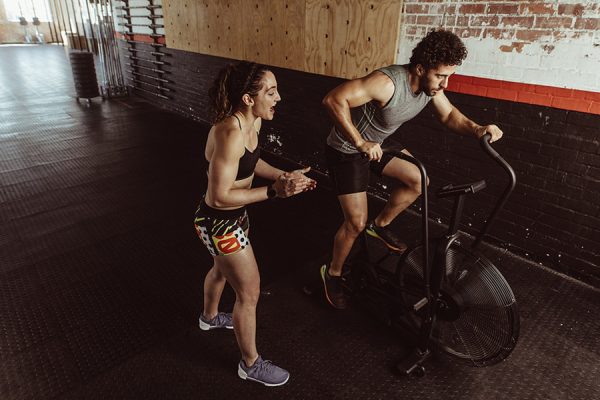Does HIIT Burn Fat Better Than Steady State Cardio?
In the last two decades, few debates have gotten as heated as the argument over high intensity interval training (HIIT) cardio versus low intensity (steady state or continuous) cardio. There was one point years ago where the pendulum in the fitness industry swung so far to the HIIT side, that both trainers and practitioners would almost mock people for “wasting their time” doing “boring” steady state, long duration cardio.

It was not unusual to see a HIIT advocate share a photo of a skinny marathon runner next to a jacked sprinter. You’d typically see a caption like, “This is what happens when you do sprints or HIIT cardio compared to steady state cardio! HIIT burns fat way better than slow, boring steady cardio, and builds more muscle too!”
Of course the truth is, that was a disingenuous argument, an unfair comparison, and according the newest research, just plain wrong.
By the way, in the latest research, they call moderate intensity steady cardio MICT, the acronym for medium intensity continuous training. It’s the same thing as medium intensity steady state (MISS) cardio, but I’m going to stick to the old name MISS, just because I’m used to it.
Types of interval and continuous cardio workouts: HIIT, SIT, MICT, MISS, LISS… Oh my!
Speaking of acronyms, it’s important to make distinctions between the different types of interval training and continuous training or else it’s hard to make fair comparisons.
In addition to HIIT, there is also sprint interval training (SIT). As seen in the scientific literature, SIT workouts typically include 2 to 6 maximal efforts (100%) lasting 10-30 seconds, with 2 to 4 minutes of active recovery in between. Although it may not involve running, we often call the work intervals sprints. These SIT workouts, even including warm up and cool down, usually don’t exceed 20 minutes. Some unique variations, such as a single round of Tabata, may take only 4 minutes (20s work X 10s rest X 8 rounds)
HIIT workouts generally refer to repeated work intervals (as many as 10 to 12) lasting 1 to 4 minutes at 90% of maximum heart rate (maybe 85% for beginners or the deconditioned). The work intervals are separated by 1 to 3 minutes of active recovery. When you count the warm up and cool down, these workouts usually last 20 to 35 minutes. (Not all HIIT workouts are super short).
Steady state cardio is the traditional type of aerobic exercise where you maintain a continuous slow or moderate pace through the entire workout, usually for a longer duration, such as 30 to 60 minutes. Steady state cardio can be further subdivided into low intensity steady state (LISS) or moderate intensity steady state (MISS).
For example, walking on flat ground (where your heart rate doesn’t go up much), is LISS cardio. Jogging or exercising on a cardio machine (stairclimber, elliptical, bike, etc) at about 75-85% of maximum heart rate is MISS cardio. MISS and LISS are not the same. MISS is obviously harder and burns more calories for a given time period.
Which type of cardio training is better for fat loss, HIIT or MISS?
Advocates of interval training often claim that HIIT is superior for fat loss as well as fitness. It’s clear that HIIT is better than MISS for time efficiency. However, whether HIIT produces more total fat loss over time than MISS has never been confirmed in well-designed long-term studies that measure body composition.
There’s been a ton of research on this topic, but with all the different types of interval training protocols out there, that has made comparing fat loss effectiveness harder than it might appear.
To finally answer this question about whether HIIT is better than MISS, a group of exercise scientists recently conducted a meta-analysis of 54 studies. (A meta analysis is not a single intervention or trial, it’s like a study of studies). The study was cleverly titled, “Slow and steady or hard and fast” and the results were published in the scientific journal, Sports (Steele, et al).
To meet the inclusion criteria, the studies had to measure body composition over time (at least 4 weeks). They also had to include a minimum of one cardio workout per week. (Most of the studies had a frequency of 3 cardio workouts per week).
What the research says about HIIT workouts for fat loss compared to steady state cardio
The results of this huge and thorough analysis gave us strong evidence that there’s very little difference between MISS and HIIT for fat loss. Neither type of cardio workout was substantially more effective for burning body fat over time than the other.
When posting memes like the marathoner versus sprinter comparison, HIIT advocates are usually trying to imply that if you do long duration steady state cardio, you’ll lose all your muscle, that HIIT is better for people who lift weights, or even that HIIT cardio can build muscle. But this study also suggested that HIIT is not more effective for building muscle.
Beginners and previously sedentary people might see a small increase in muscle when they start doing intense cardio. Cardio with a resistance element might add a little muscle as well. But the fact is, cardio in general is not very effective for muscle growth. You have to lift weights for that. And surprise, surprise, sprinters usually do a lot more heavy lifting than long distance runners.
Without strict dietary control, adding modest amounts of cardio alone is not very effective for fat loss
The researchers also made a somewhat disappointing discovery. Regardless of whether the cardio type was HIIT or MISS, the amount of body fat lost was rather small. In previous studies, we’ve seen other cases where 4 to 12 week interventions produced only a modest fat loss of 2 to 4 pounds of fat loss. In one of those studies, the interval training group burned a pound more than the steady state training group.
But in this newest analysis of 54 different studies, there was no significant difference between the HIIT and MISS and the total weight loss was only around a measly half a pound. This suggests that without dietary control, the effect of moderate doses of either type of cardio on fat loss is minimal (remember, the average frequency was only 3 cardio sessions a week).
Dietary restriction (achieving calorie deficit) must always be the first priority put in place for fat loss. It’s easier to achieve a large calorie deficit by reducing food intake than by increasing exercise.
Make no mistake, exercise does help with fat loss, when added on top of a proper diet. You also get a myriad of health and fitness benefits. The issue is that it takes a fairly large volume of cardio to move the fat loss needle. Plus, if you exercise and then proceed to eat more when you add more cardio, that simply cancels out the fat loss benefit.
Exercise, both resistance and cardio training, is an important adjunct to diet. But the cliche, “you can’t out train a bad diet” has a lot of truth to it.
The biggest advantage of HIIT
One of the biggest advantages of HIIT is that the time commitment to achieve similar fat loss, fitness and health benefits is lower. Time efficiency is a major benefit of HIIT training.
There’s a trade off though. Much more intensity of effort is required for HIIT. Some people find the effort required to perform HIIT uncomfortable and painful. All-out sprint interval training (SIT) can feel downright puke-inducing. This is why some people simply prefer to exercise slower and longer for the same results.
On the other hand, some people find slower steady-state cardio mind-numbingly boring and intense interval training far more engaging.
Because the scientific evidence shows there’s little difference in fat loss over time between HIIT and MISS, and because adherence is the key to results, here is the biggest lesson we can draw from this research:
Your own personal preference should guide your choice of cardio.
Your time available may also influence your choice. The time efficiency benefit can make HIIT an excellent choice for busy people.
HIIT workouts for fat loss
Instead of stopping here and leaving you only with the findings from a bunch of scientific studies, I thought I’d leave you with two examples of interval training workouts that are outstanding for fat loss.
I want to emphasize that I didn’t write this post to knock HIIT, only to say that HIIT is not superior for fat loss. HIIT can be a great choice and as mentioned above, the biggest benefit and biggest place where HIIT wins over steady, lower intensity cardio is with time-efficiency.
I enjoy walking and hiking for cardio, which would be considered LISS. It may not be the most efficient training, but I often walk for hours every week for health and enjoyment alone. If I want to maximize fat loss while being efficient with my time, I often use a combination of steady state and HIIT cardio workouts. You don’t have to take a side and choose one or the other. I’m a big fan of running hills and stairs for HIIT or SIT as well. When I’m using cardio machines, my favorite HIIT fat loss workout of all is the 10 X 1 protocol.
Regardless of the protocol used, HIIT is usually only done 2 or 3 days a week because it is so intense. If additional cardio sessions are desired to help boost fat loss, they should be lower in intensity to avoid over-training (LISS OR MISS), especially when done concurrently with weight training.
10 X 1 HIIT workout for fat losss
The 10X 1 HIIT workout is a scientifically tested protocol where you do 10 rounds of 1 minute intervals at a high, but not maximum intensity. Using the rating of perceived exertion scale, the work intervals would be about a 9. After each work interval, you take a 1 minute recovery interval at a low intensity. The RPE would be about a 3 or 4.
Most people start with a 3 to 5 minute warm up and end with a 3 to 5 minute cool down. That makes the total time of the workout between 26 to 30 minutes. You accumulate 10 minutes of high intensity effort during this workout.
Beginners or deconditioned people could start with only 4 to 6 work intervals and build up to 10 intervals. Beginners could also start with a lower intensity such as a 7 or 8 RPE on the work intervals and build up to a 9 RPE. Advanced and highly fit trainees could do as many as 12 intervals and also aim for a 9.5 to 10 RPE.
The best HIIT workout for fat loss
Norwegian 4 X 4 HIIT (long intervals)
The 4 X 4 Norwegian method involves 4-minute high intensity work intervals repeated 4 times, with 3 minute recovery intervals in between.
Most of the studies on 4 X 4 HIIT are done with an intensity at 90-95% of maximal heart rate during the work intervals, but you sometimes hear 85% to 95% as the acceptable range. This intensity would be equivalent to running at a brisk pace. Using the 10 point RPE scale, this would be an effort level of at least an 8 or even a 9. During the 3-minute recovery periods, you reduce the intensity to the equivalent of a slow jog or brisk walk (depending on your fitness level). That would be about a 3 to 4 RPE.
Followed as instructed above, this workout is 25 minutes long, not counting warmup. With a 3 to 5 minute warm up and cool down, the total workout time is 31 to 35 minutes long. You accumulate a whopping 16 minutes of high intensity effort.
This is a lung-burning, heart-pounding workout. I find it feels much harder than 1-minute intervals. But surprisingly, participants in 4 X 4 HIIT studies did not report any difference in enjoyment between HIIT workouts with 1-minute work intervals and 4-minute intervals. It appears that the long recovery interval of 3 minutes makes the workout quite tolerable.
If you find 4 minute intervals too difficult, you could try starting with 2 or 3 minutes (still considered long intervals) and then build up over time as you get fitter.
What about SIT workouts and Tabata for fat loss?
Some interval training protocols are designed to be extremely brief. You often hear about 4-minute, 7-minute, 8-minute, or 10-minute cardio workouts and see them advertised for promoting fat loss.
The Tabata protocol for example, is only 4 minutes long. It consists of 20 second work intervals alternated with 10 second recovery intervals repeated 8 times. That’s one round. Sometimes Tabata is promoted as “only 4 minutes long” (as in doing only one round), or you may be instructed to repeat two or three times, for a total of 8 or 12 minutes of total time, respectively. In any case, it’s a short workout (SIT workouts are shorter than HIIT workouts).
Although I’ve been referring to cardio modalities like running, jogging, cycling and cardio machines, SIT is often done with bodyweight exercises or resistance exercises. For example, SIT workouts may involve calisthenics like burpees or weighted exercises like kettlebell swings or squat thrusters
The good news is, very brief, very intense SIT workouts have been shown to produce large cardio-respiratory and health improvements in minimal time. The bad news is, if a workout is only 4, 8 or even 12 minutes long, the total calorie expenditure is simply not high enough to burn a lot of fat, so it’s important to consider fat loss and cardiovascular conditioning and health as distinct goals. You can say one 4-minute round of Tabata or other types of SIT workouts are incredibly time efficient for cardiovascular improvement, but you can’t honestly say they’re good fat burners.
What about the afterburn effect (EPOC from sprint interval workouts?
Upon hearing that you can’t burn much fat in a workout that is only minutes long, some HIIT/SIT advocates say,”What about the afterburn effect (EPOC)? Don’t you keep burning fat for hours after a short but high-intensity workout is over?” EPOC, which means excess post exercise oxygen consumption, is the increase in metabolism after a hard workout. It’s a real phenomenon.
One study from Arizona State University confirmed the hypothesis that sprint interval training (SIT) produced a greater EPOC and post-exercise fat oxidation than both HIIT and MISS (calorie burn after the workout). After a SIT workout consisting of 6 30-second maximal intervals, there was an additional burn of over 200 calories, which is indeed significant.
However, despite the higher afterburn effect from certain SIT workouts, both the HIIT and MISS cardio burned more total calories than SIT cardio when the calories burned both during and after were added up. It’s also worth noting that another study showed a similar increase (more than 200 calories of EPOC) after a 45 minute steady state cardio workout done at moderately-high intensity. This revealed that EPOC is not exclusive to interval training and that it’s influenced by duration of exercise as well, not just intensity alone.
This cast doubt on the popular belief that sprint interval cardio is superior for fat loss because of a greater metabolism boost after the exercise session is over. furthermore, in most cases, the calorie burn after a cardio workout is not as big as previously believed. What impacts fat loss the most is the total calories burned overall, and the majority of calories burned from intense cardio occur during, not after the workout.
Studies have also found out that the EPOC effect does not last as long as previously believed. Have you ever heard that if you do intense interval cardio, you’ll keep burning calories at an elevated rate for 24 hours or even longer after the workout is over? Technically it may be true, but the majority of the extra calories are burned in the 3 hours immediately after the workout and then there’s a sharp decline in the hours that follow.
Because SIT workouts are so brief, the calories burned during the workout end up being fewer than HIIT or MISS cardio, so despite the greater afterburn from SIT, in the end, it’s essentially a wash. Whether you do maximum intensity with short duration, high intensity with moderate duration, or medium intensity with long duration – the calorie burn is very similar.
In a 2019 study in the British journal of Sports Medicine, 3 different types of cardio were compared over a 4 to 12 week period. When you included the warm up and cool downs, the total duration looked like this:
MISS: 35 sessions X 38 min per session = 1330 minutes.
HIIT: 33 sessions X 28 min average = 924 minutes.
SIT: 29 sessions X 18 minutes = 526 minutes.
All 3 of these cardio programs produced similar results in fat loss after 4 to 12 weeks. The interval training workouts saved time, especially SIT, but the HIIT workouts required close to a half an hour on average. You can’t escape it – it takes a certain amount of time for the calorie burn to add up and translate into decreased body fat loss
Intense, but very short interval protocols that last only minutes can be surprisingly effective for improving cardiovascular fitness and health markers, but it’s a myth that you can do 4-minute or 7-minute workouts and burn a lot of fat. You can only burn so many calories per minute. Workout duration matters, not just intensity alone. Multiply the two and that will determine your rate of calorie burn, and subsequent fat loss.
In conclusion, does HIIT burn fat better?
Yes, HIIT can be a good way to burn fat. HIIT workouts in the 25 to 35 minute range are especially good for fat loss. If you only need a really short warm up and cool down, even 20 to 25 minutes of HIIT can produce good fat loss results. When the intensity is maximal (SIT), even shorter workouts of less than 20 minutes can also be good fat burners.
Brief SIT workouts are not as effective for fat loss as HIIT or MISS, even when you count the EPOC effect. Sprint-style cardio burns more calories per minute, but the workouts are too short for the calorie burn to add up and translate into much fat loss.
Is 30 minutes of HIIT enough to lose weight? Absolutely. Even 20 to 25. But don’t forget, steady state continuous cardio in the 40 to 60 minute range works great for weight loss too, and some people find it more enjoyable and tolerable because the intensity is lower. Even LISS helps with fat loss, but plan on spending a lot more time, even an hour or more per session, to get a similar amount of fat loss you’d get from a HIIT session.
At this point, I think we can finally put the HIIT vs MISS for fat loss debate to an end. It’s time to stop saying HIIT is better for fat loss. It’s more accurate to say that HIIT is more time-efficient. You can increase your fat loss with any kind of cardio, the low and medium intensity types will simply require more time.
The take-home message is, do your cardio, and choose the type that you enjoy the most, that you can stick to and is best suited for your goals.
Combine different types of cardio if you choose as well. If fat loss is your goal, alternating HIIT or SIT with LISS or MISS can bump your weekly calorie burn with less risk of overtraining. If endurance is your goal, studies have found that using more than one type of cardio (“polarized training”) resulted in the greatest improvements in most key variables of endurance performance in trained athletes.
And remember, no type of cardio is going to help you lose much fat if you aren’t controlling your diet to make sure you’re in a calorie deficit.
Tom Venuto,
Author of Burn the Fat, Feed the Muscle (BFFM) – The Bible Of Fat Loss
Author of The BFFM Guide To Flexible Meal Planning For Fat Loss
Founder, Burn the Fat Inner Circle

Tom Venuto is a natural bodybuilding and fat loss expert. He is a former competitive bodybuilder and today works as a full-time fitness coach, writer, blogger, and author. In his spare time, he is an avid outdoor enthusiast and backpacker. His book, Burn The Fat, Feed The Muscle is an international bestseller, first as an ebook and now as a hardcover and audiobook. The Body Fat Solution, Tom’s book about emotional eating and long-term weight maintenance, was an Oprah Magazine and Men’s Fitness Magazine pick. Tom is also the founder of Burn The Fat Inner Circle – a fitness support community with over 55,000 members worldwide since 2006. Click here to learn more about Burn the fat Inner Circle
Scientific reference:
Steele et al, Slow and Steady, or Hard and Fast? A Systematic Review and Meta-Analysis of Studies Comparing Body Composition Changes between Interval Training and Moderate Intensity Continuous Training, Sports, 9, 155, 2021.






I would venture that the biggest predictors of success are compliance, consistency, and sticking with it for the long term. From that perspective, lower intensity training that develops aerobic endurance is how endurance athletes build the ability to perform workouts at high power yet not work at physiological “high intensity.” Thus, they can feel able to repeat the workout the next day, and the next, and the next without risk of mental burnout or injury. For me, this is the route to success, too even though I cannot achieve their power output. I focus on my perceived effort so that I, too, can not worry about mental fatigue and focus on being able to recovery and repeat. I know that, over time, my power will develop. I’ve got the wrong tense there….this has been the outcome for me although I’m not able to match the power of “real” endurance athletes. Boredom? Solve that as a separate problem. Takes a long time? One is fooling oneself if one does not see this as a lifelong commitment. Rush, and you’ll just get there slower. My wife is a furnace. She eats and eats and gets skinnier and skinnier. Triathletes are so annoying when they do that.
Hey Ed! good to hear from you! Good insights there. And yes of course consistency and adherence. The interesting part is that people have disagreed about whether adherence /consistency was better for HIIT vs MISS for years, but all along it appears to be a matter of fitness level and personal preference.
Eat less, eat better, exercise just beyond your comfort level. Adjust as necessary.
simple right?
Risk of injury increases with short-term intensity? Particularly in running..sprinting?
Ken, yes you are right. sprinting, as in running as fast as you can, indeed has extremely high risk of injury, especially hamstring strains or even tears. risk is less if running uphill and also going all out on cardio machines.